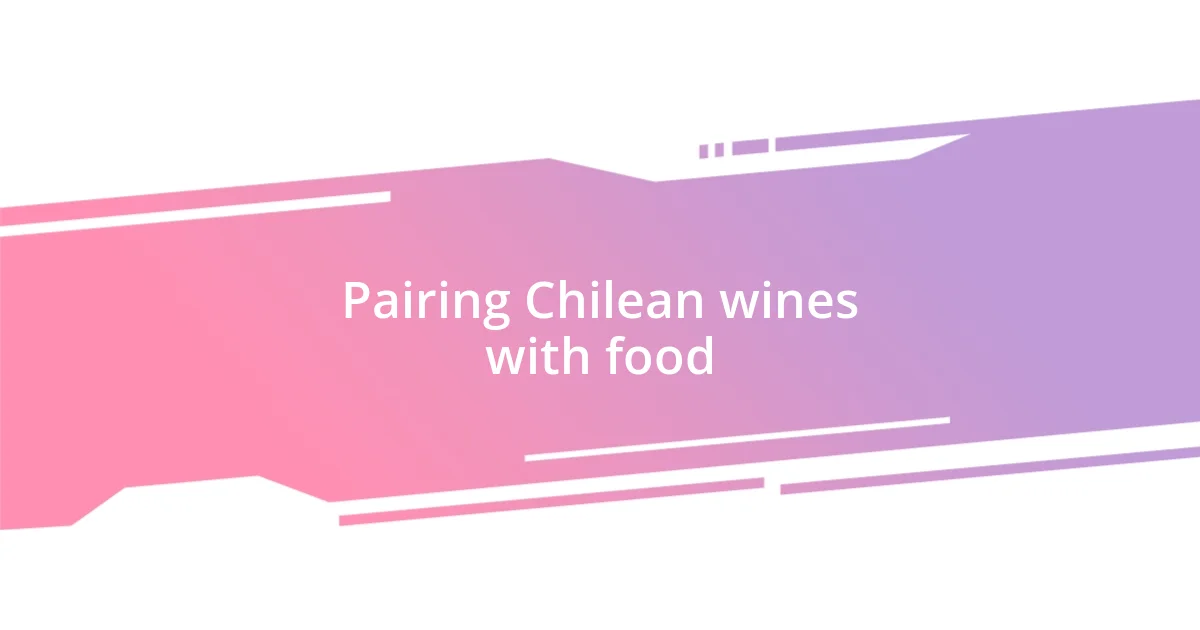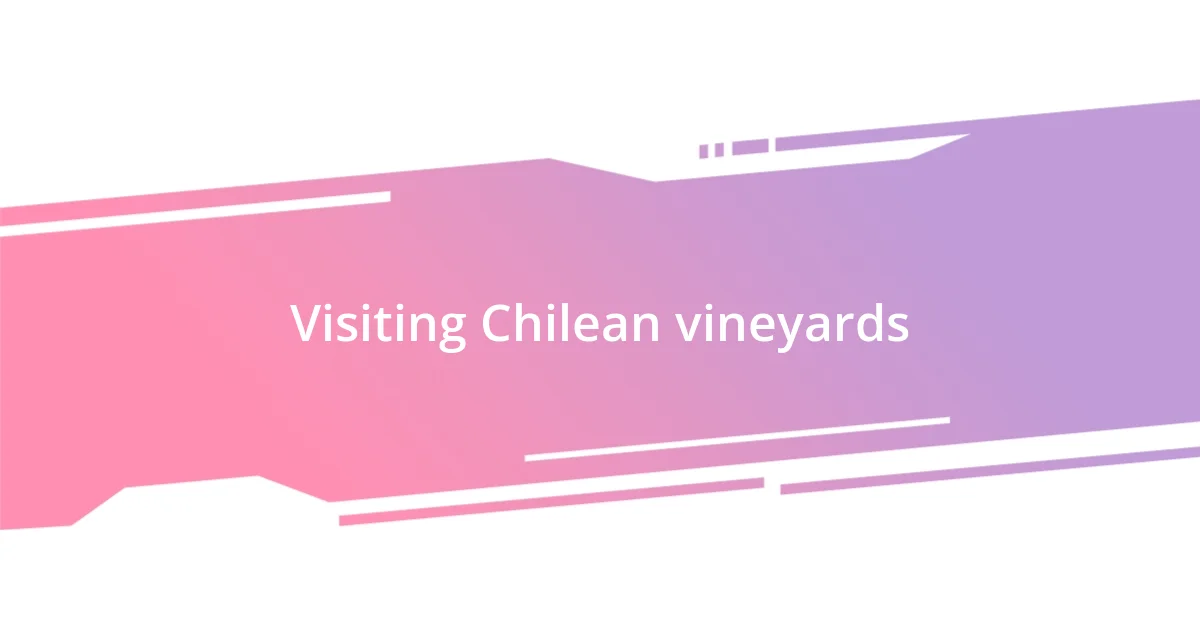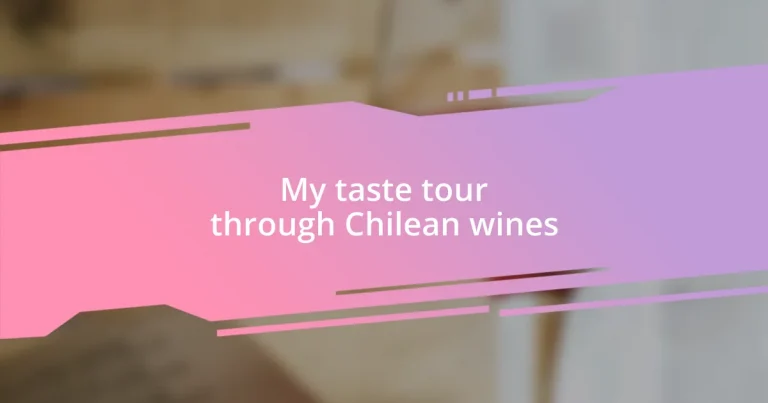Key takeaways:
- Chilean wine production, dating back to the 16th century, is influenced by the country’s diverse geography, offering unique microclimates that shape distinct wine flavors.
- Key grape varieties like Carménère, Cabernet Sauvignon, and Sauvignon Blanc exemplify Chile’s wine identity, each providing unique tasting experiences that resonate with cultural connections.
- Visiting vineyards in Chile enriches the wine experience, fostering a deeper appreciation for the interplay of terroir, winemaking traditions, and the community behind each bottle.

Introduction to Chilean wines
Chilean wines have intrigued me from the very first sip, with their unique flavors and rich heritage. Did you know that Chilean wine production dates back to the 16th century when Spanish missionaries first planted vines? This long history gives each bottle an intricate story, making the discovery of a new wine an exciting journey.
What truly captivates me about Chilean wines is their diverse geography, which creates a plethora of distinct microclimates. From the cool coastal breezes of Casablanca Valley to the arid conditions of the Atacama Desert, the variety is astonishing. I remember my first tasting of a Carménère from the Colchagua Valley, and how its deep, bold notes felt like an embrace on a chilly evening—a perfect description of how terroir influences taste.
Exploring Chilean wines is not just about drinking; it feels like an exploration of culture and tradition. Have you ever found yourself transported by a specific vintage? I often recall the evening spent sharing a bottle of País with friends, laughing and connecting over the wine’s rustic charm and history—as if each glass held the essence of Chile itself.

Geography of Chilean wine regions
Chile’s geography is a wine lover’s dream, offering a stunning range of regions that contribute distinct flavors and characteristics. Each area has its unique climate, soil composition, and elevation, resulting in wines that truly express their origins. I still remember my visit to the Maipo Valley, where the Andes mountains guard the vineyards, creating a breathtaking backdrop. The Cabernet Sauvignon from this region is something I can never forget—the vibrant fruit flavors felt like sunshine captured in a glass.
The key wine regions of Chile are:
– Maipo Valley: Known for rich Cabernet Sauvignon and Syrah, benefiting from the Andes’ protective embrace.
– Casablanca Valley: Renowned for white varieties like Sauvignon Blanc and Chardonnay, crafted by the cool coastal climate.
– Colchagua Valley: Famous for its bold reds, particularly Carménère, sitting securely in the heart of the Central Valley.
– Aconcagua Valley: Offers both red and white varieties, where the warm days and cool nights lead to complex flavors.
– Elqui Valley: Positioned further north, it stands out for high-altitude wines with unique mineral qualities, especially in its Syrah and Sauvignon Blanc.
– Humahuaca Valley: Lesser-known but full of potential, producing exciting wines from unique terroirs.
Each of these regions, with its distinct personality, invites exploration and discovery. It’s exhilarating to know that every bottle tells a story shaped by the land it comes from.

Key grape varieties in Chile
When I think of key grape varieties in Chile, a few stand out that perfectly embody the essence of the country’s wine narrative. Carménère, often considered Chile’s flagship grape, offers rich berry flavors, spicy notes, and a velvety finish. I recall tasting a vintage with friends on a balmy evening, where the wine’s complexity sparked vibrant discussions about its history and our travels. It’s a grape that feels like a true reflection of Chilean identity, having roots that tie back to the Bordeaux region yet evolving into something uniquely South American.
Another vital player in Chile’s wine scene is Cabernet Sauvignon. Known for its bold character, it thrives in the Maipo Valley’s fertile soils. I vividly remember uncorking a bottle during a family gathering, where the deep flavors filled the room, leading us all to reminisce about our favorite family moments over a glass. This grape, with its firm tannins and rich fruit profile, often serves as a bridge for newcomers to the world of wine, inviting every palate to embrace its allure.
Sauvignon Blanc deserves a spot on this list as well, especially for its zesty and refreshing qualities. The Casablanca Valley, with its cool coastal winds, seems to produce deliciously vibrant versions that are hard to resist. I once enjoyed a chilled glass on a sunny afternoon, paired with a fresh seafood dish, and the pairing was simply unforgettable. It’s this harmony between the grape and our culinary experiences that truly showcases the vibrant expression of Chilean terroir.
| Grape Variety | Characteristics |
|---|---|
| Carménère | Rich berry flavors, spicy notes, velvety finish |
| Cabernet Sauvignon | Bold character, firm tannins, rich fruit profile |
| Sauvignon Blanc | Zesty, refreshing, vibrant qualities |

Wine tasting techniques in Chile
The art of wine tasting in Chile is a delightful experience that engages all your senses. As I took my first sip of a velvety Carménère in a sun-drenched vineyard, I marveled at how the flavors danced on my palate. Have you ever felt the rush of excitement as a wine’s characteristics unfold with each taste? I certainly did, discovering rich fruit and subtle spice that seemed to narrate the story of its origins.
When tasting Chilean wines, I learned the importance of proper technique—swirling the glass to release aromatic compounds is critical. I remember a particularly enlightening moment during a tasting session in Casablanca Valley. The citrus and floral notes of a Sauvignon Blanc quickly became apparent as I swirled and inhaled deeply. It’s almost as if the wine communicates with you, inviting you to pause and appreciate its complexities.
The local culture also enriches the tasting experience, as I’ve found that sharing a bottle with friends often leads to spirited discussions about our impressions. One evening, as I savored a bold Cabernet Sauvignon surrounded by laughter and lively chats, it dawned on me how much these moments are intertwined with the wine we enjoy. It’s not just about tasting; it’s about connection. Have you ever noticed how a great wine enhances not just the meal, but the company as well?

Pairing Chilean wines with food
Pairing Chilean wines with food is truly an adventure in flavors. I recall a delightful evening at a local restaurant where I paired a robust Carménère with a spicy beef empanada. The wine’s velvety texture complemented the richness of the meat and balanced the spice perfectly, transforming each bite into a culinary journey. Have you ever experienced that moment when the right wine can elevate a dish to new heights? It’s magical.
Then, there’s the unmistakable charm of Sauvignon Blanc, which I discovered while enjoying a fresh ceviche. The vibrant acidity of the wine cut through the zesty citrus and tender fish, enhancing every aspect of the meal. I find that when I select the right wine for seafood, it not only refreshes my palate but also connects me to coastal Chile, where these flavors thrive. How often do it feel the connection between the dish and the wine you’re sipping? For me, it’s a bridge to the region’s radiant culinary traditions.
And let’s not forget the power of Cabernet Sauvignon, particularly with grilled meats. I vividly remember a barbecue with friends, where the bold wine harmonized beautifully with the smoky flavors of the grilled lamb. Each sip deepened the experience, sparking conversations about the vineyards and the rich history behind each bottle. Have you ever savored a wine that made you feel as if you were part of its story? That’s the communion of food and wine—an experience that resonates long after the last drop is savored.

Visiting Chilean vineyards
Visiting Chilean vineyards is like stepping into a living postcard. I remember arriving at a picturesque winery in the Colchagua Valley, where rows of grapevines stretched out under a brilliant blue sky. The sheer beauty of the landscape took my breath away, and I felt an overwhelming sense of connection to the land that produces such remarkable wines. Have you ever been in a place where the ambiance makes you appreciate the experience even more?
As I wandered through the vineyard, I was fortunate to meet the local viticulturist, who eagerly shared stories of the terroir. He explained how the diverse climates and soils contribute to the unique characteristics of Chilean wines. Listening to his passion, I felt a deeper appreciation for every bottle I had tasted. It’s fascinating how the land, weather, and even the farmer’s touch can shape the wine we put in our glasses. Isn’t it amazing how people and place intertwine in such an intimate way?
During a vineyard tour, I took part in the grape harvest, a hands-on experience that left an indelible mark on my memory. The energy of the pickers, the laughter, and the collective effort to gather the fruit made me feel a part of something bigger than myself. It was a reminder that each bottle tells a story—one of hard work, dedication, and community. Have you ever felt that sense of belonging while participating in a local tradition? It’s exhilarating, and I found myself more compelled to explore the wines that emerged from those very vines.

Recommendations for Chilean wine selections
When it comes to choosing Chilean wines, I highly recommend starting with a vibrant Chardonnay from the Casablanca Valley. I still recall uncorking a bottle for a get-together with friends; its crispness and notes of green apple made every sip a refreshing experience. Have you ever had a wine that felt like a warm hug on a sunny day? This Chardonnay not only complemented our light summer dishes but also sparked lively conversations, making the evening unforgettable.
For a touch of adventure, don’t overlook the lesser-known País grape. I remember trying it at a small local wine bar—its berry-rich profile surprised me with its earthy undertones. It paired beautifully with a charcuterie board, reminding me of the rustic charm of traditional Chilean gatherings. Isn’t it exhilarating to discover a hidden gem that brings a unique perspective to your palate?
Lastly, for a bold choice, I suggest a Gran Reserva from the Maipo Valley. I once savored a bottle during a quiet dinner on a rainy evening. Its deep flavors and complexity felt like a cozy blanket wrapping me in warmth. This wine truly elevated the simple meal I prepared, prompting me to reflect on the evolving story behind each vintage. How often do you find a wine that resonates with your emotions and the moment you’re in? That’s the beauty of exploring Chilean wines—their ability to create an intimate connection with the experience.














